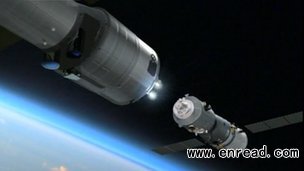| ||||||||||||||||||||||||||||||||||||||||||||||||||||||||||||||||||||||||
|
China has taken the next step in its quest to become a major space power with the launch of the unmanned Shenzhou 8 vehicle. 中国成功发射神舟8号无人飞船,向成为太空强国迈进一步。  It will be a couple of days before Shenzhou 8 is in a position to attempt the docking It would be the first time China has joined two space vehicles together. The capability2 is required if the country is to carry through its plan to build a space station by about 2020. The Long March carrier rocket lifted away from the Jiuquan spaceport in the Gobi Desert at 05:58, Tuesday. TV cameras relayed the ascent3 to orbit. Shenzhou separated from the rocket's upper-stage about nine minutes into the flight. Confirmation4 that its solar panels had been deployed5 was received a short while after. It will be a couple of days before Shenzhou is in a position to attempt the docking, which will occur some 340km above the Earth. The vehicles will be using radar6 and optical sensors7 to compute8 their proximity9 to each other and guide their final approach and contact. The pair will then spend 12 days circling the globe together before moving apart and attempting a re-docking. Finally, Shenzhou 8 will detach and its return capsule will head back to Earth. 点击  收听单词发音 收听单词发音
|
||||||||||||||||||||||||||||||||||||||||||||||||||||||||||||||||||||||||
上一篇:联合国对利比亚武器储备表示“担忧” 下一篇:以色列加速居民点建设计划 |
||||||||||||||||||||||||||||||||||||||||||||||||||||||||||||||||||||||||
- 发表评论
-
- 最新评论 进入详细评论页>>



